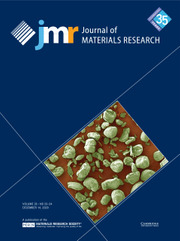Article contents
Oxygen Permeability of Ferroelectric Thin Film Top Electrodes and Its Effect on Detectable Fatigue Cycling-Induced Oxygen Isotope Motion
Published online by Cambridge University Press: 03 March 2011
Abstract
We investigated the discrepancy between the significant 18O isotope motion observed after bipolar voltage cycling used to induce ferroelectric fatigue in unannealed Pt/Pb(Zr,Ti)O3/Ir (PZT) capacitors and the lack of any observable oxygen tracer motion in annealed capacitors. We found that while unannealed Pt electrodes are permeable to oxygen, annealed Pt electrodes are oxygen impermeable. Further, when the initial oxygen tracer profile does not vary strongly with depth, the ability to detect oxygen motion during fatigue voltage cycling depends critically on the oxygen permeability of the capacitor’s top electrode. Our results indicate that oxygen exchange between the PZT film and external oxygen sources and sinks during voltage cycling is not necessary for ferroelectric fatigue to be manifest. In addition, studies of the dependence of ferroelectric materials properties on ambient gases should be accompanied by analysis of the permeability of exposed surfaces to the gases of interest.
Keywords
- Type
- Articles
- Information
- Copyright
- Copyright © Materials Research Society 2004
References
REFERENCES
- 6
- Cited by


